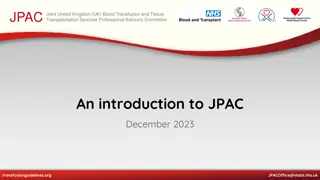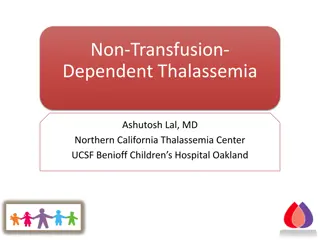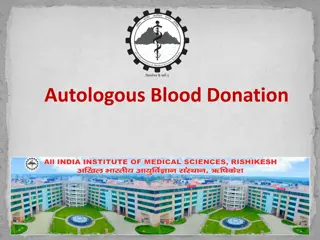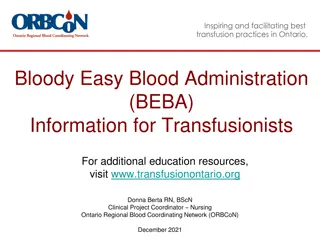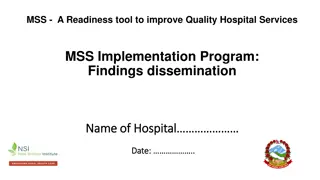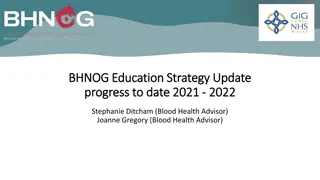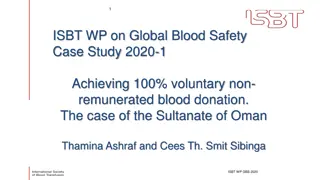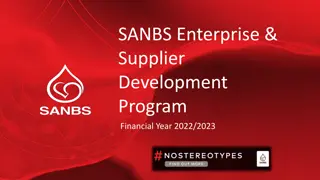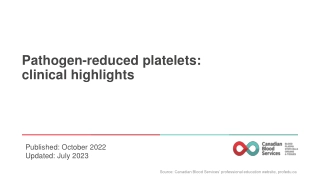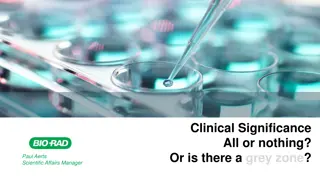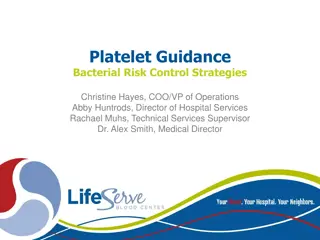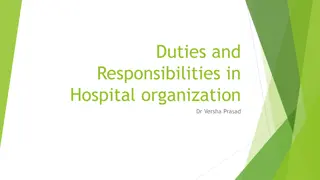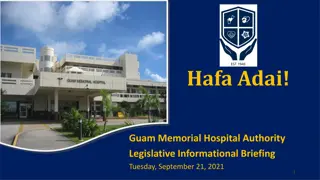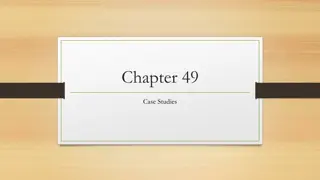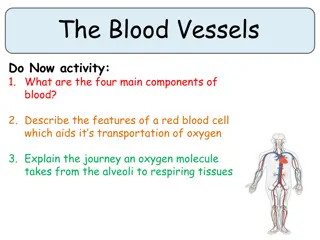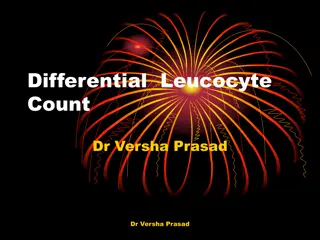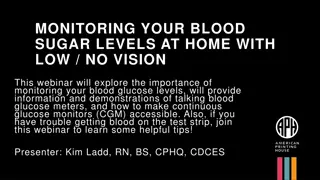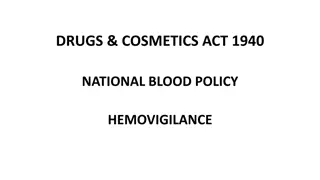Implementation of Electronic Crossmatch in Blood Transfusion at Letterkenny University Hospital
This review explores the implementation of Electronic Crossmatch (EXM) in the Blood Transfusion Department at Letterkenny University Hospital. It discusses pretransfusion testing, crossmatching techniques, benefits, and challenges of EXM. The study aims to assess the benefits of EXM and identify ways to enhance patient and sample eligibility without compromising safety.
Download Presentation

Please find below an Image/Link to download the presentation.
The content on the website is provided AS IS for your information and personal use only. It may not be sold, licensed, or shared on other websites without obtaining consent from the author. Download presentation by click this link. If you encounter any issues during the download, it is possible that the publisher has removed the file from their server.
E N D
Presentation Transcript
A Review of the Implementation of Electronic Crossmatch in the Blood Transfusion Department at Letterkenny University Hospital Eimear Carr1,2 Supervisors: Barr, C.,1and Cregg, H.2 1. Blood Transfusion Department, Letterkenny University Hospital 2. Department of Biopharmaceutical and Medical Science, Atlantic Technological University, Galway
Introduction Pretransfusion testing consists of ABO/RhD grouping, antibody screening and crossmatching [1]. Performed before red cell units are issued to ensure compatibility between donor and recipient. This is important to ensure: o Maximal survival of donor red cells post transfusion. o Minimise the risk of haemolytic transfusion reactions (HTRs) [2]. [3]
Crossmatching Techniques The crossmatch is used to determine compatibility between red cell antibodies in the recipient s plasma and antigens expressed by donor red cells [1]. Electronic Crossmatch (EXM) Indirect Antiglobulin Test Crossmatch (IAT XM) Crossmatching Techniques Serological Crossmatch (SXM) Immediate Spin Crossmatch (IS XM)
Pretransfusion Testing Red Cell Antibodies Detected No Red Cell Antibodies Detected 1. Antibody identification 1. EXM given all other criteria are met e.g. sample is less than 72 hours old, no history of antibodies, consistent historical and current ABO/RhD group [1]. 2. Phenotyping of recipient and donor red cells 3. IAT XM [1].
EXM Benefits Increased safety. Decreased turnaround times Reduced workload. Decreased expenditure. Reduced red cell inventory Decreased crossmatch to transfusion (CT) ratio [4]. Disadvantages Information technology (IT) downtime. Risk of HTRs due to antibodies against low incidence antigens Financial barriers [4]. [5]
Purpose of the Study To determine the benefit of implementing EXM at Letterkenny University Hospital (LUH) as a crossmatch method. To determine improvements which could be made to increase patient and sample eligibility for EXM without compromising patient safety.
Materials and Methods Data on units issued from 30/04/19 to 31/03/22 were extracted from LIMS to determine the percentage of units issued by EXM and IAT XM. The CT ratio was calculated using data extracted from the LIMS from 2016-2021. CT ratio = number of units crossmatched number of units transfued Red cell inventory and expenditure on red cell units was determined through the analysis of stock kept in 2017-2018 and 2020-2021. o Excluded 2019 since it would not reflect the annual impact of EXM. [3]
Materials and Methods IIIII O RhD NEGATIVE Expenditure on consumables for the IAT XM in 2018 and 2021 was determined per one unit crossmatch from the financial database. Red cell units expired from 2018-2021 was determined from quality reports. The reasons for exclusion from EXM was evaluated for units issued by IAT XM from 30/04/19 to 31/03/22. Antibodies identified during this time were also determined from the LIMS.
Results In total, 7,650 units were issued to 1,718 patients and of those units issued 5,997 red cell units were transfused to 1,519 patients. EXM was used to issue 67% (5098/7650) red cell units and 29% (2255/7650) were issued by IAT XM. [3]
CT Ratio Pre and Post Implementation of EXM Introduced on 30/04/19 1.80 1.66 1.66 1.54 Corssmatch:Transfused Ratio 1.60 1.32 1.40 1.26 1.20 1.20 1.00 0.80 0.60 0.40 0.20 0.00 2016 2017 2018 2019 2020 2021 Date (Year) Figure 1. CT ratio from 2016-2021 which was shown to decrease since EXM was implemented on 30/04/19.
Table 1. Average Number of Red Cell Units Received from the Irish Blood Transfusion Service (IBTS) Pre and Post Implementation of EXM with Cost Implications. The difference in red cell inventory and cost savings is also given. Number of Red Cell Cost Implicated ( ) Units Received from IBTS Average 2017 -2018 2,587 763,018 Average 2020 -2021 1,930 569,350 Difference 657 193,668
Table 2: Expenditure on consumables for the IAT XM in 2018 and 2021 including cost saving. 2018 2021 Cost Saving Expenditure on 4,832.74 1,011.56 3,821.18 Consumables ( ) The estimated annual saving in red cell units and consumables together at LUH was 197,489.
Annual Number of Expired Red Cell Units from 2018 to 2021 160 135 130 140 115 120 105 Number of Units 100 80 60 40 20 0 2018 2019 2020 2021 Date (Year) Figure 2. Annual number of red cell units which expired from 2018-2021.
Reasons Red Cell Units Issued by IAT XM were Excluded from EXM 10.5% 2.4%4.3% Antibodies 1.9% Current Not Auto-filed 38.3% Less than 1 Year Old Historical Not Auto-filed Transplant 20.0% Requires IAT Crossmatch CyberAttack IAT Crossmatch Chosen 22.0% 0.6% Figure 3. Reasons red cell units were excluded from EXM are depicted above.
Reasons for Current Sample Auto-filing Failures 7.2% 0.4% 12.7% 16.5% 58.1% 5.0% Analyser modified result Dual Population Flag Manually Entered Group QA Failure Referred Screen Unknown Reason Figure 4: Reasons for current sample auto-filing failures can be seen in pie chart above. Reasons for quality assurance (QA) failures included samples greater than 72-hours-old and discrepancies between current and historical groups. Reasons for manually entered ABO/RhD grouping results included dust on ABO/RhD grouping cards which interfered with analyser interpretation of results.
Antibodies Identified in 128 Patients from 30/04/19 to 31/03/22 Anti-Cw 1 Anti-P1 1 Anti-Kpa 1 Anti-c 1 Antibodies Identified Anti-Lua 1 Referred 1 Anti-Bga 1 Autoantibodies 2 Anti-Fya 2 Anti-Jka 2 Anti-Kell 3 Anti-M 6 Anti-E 9 Anti-D** 35 Multiple 62 0 10 20 30 40 50 60 70 Number of Patients with the Antibody in their Serum Figure 5: Antibodies Identified in Patient Samples during Pretransfusion Testing Resulting in Exclusion from the EXM. **Anti-D includes immune and prophylactic anti-D.
Discussion The CT ratio decreased post implementation of EXM (figure 1). [3] o Important to ensure effective usage and to minimise outdating of red cell units [6]. o A CT ratio of 1.2 has been suggested as an indicator of effective blood usage [6]. Red cell inventory and expenditure on red cell units decreased post implementation of EXM (table 1). o Currently important due to the national blood shortage [8]. Expenditure on consumables for IAT XM decreased post implementation of EXM.
Discussion IIIIII O RhD NEGATIVE EXM had minimal impact on red cell unit expiry (figure 2). o Indicates other factors such as distance of LUH from IBTS contribute to red cell unit expiry. Auto-filing failures contributed to 42% (948/2255) of exclusions from EXM (figure 3). [7] o Limiting non-ABO specific transfusions and implementing re-routing schemes could reduce dual population flags. o Change methods used to cancel requests and strict adherence to SOPs could limit QA failures.
Discussion IIIIII O RhD NEGATIVE Antibodies contributed to 38% (864/2255) of exclusions. o Most antibodies identified were clinically significant. o Continual review of the number of patients with clinically insignificant antibodies to assess whether clinically insignificant antibodies should result in EXM exclusion.
Conclusion EXM was shown to be beneficial by reducing expenditure and aiding conservation of red cell units by decreasing CT ratio and red cell inventory. Suggestions to increase EXM eligibility included limiting non-ABO specific red cell transfusions and re-routing scheme with another hospital for red cell units nearing expiration. A change in the method used to cancel ordered requests and strict adherence to SOPs could also increase EXM eligibility. In consequence these improvements could further reduce expenditure and help in the conservation of red cell units. IIIII O RhD NEGATIVE
Acknowledgements IIIII O RhD NEGATIVE I would like to thank Dr Jacqui Clarke for allowing me to carry out my project in the Blood Transfusion Department at Letterkenny University Hospital. I would like to thank Charlie Barr and Kathleen King for their support and guidance throughout my project. I would like to thank all blood transfusion staff for their help throughout my project. I would like to thank Annette Darcy, Charlie Barr, Dr Jacqui Clarke and Kathleen King for proof-reading my thesis. I would like to thank Helen Cregg, my college supervisor for all her feedback and advice throughout my project. I would like to thank Dr Eleanor Rainsford for her advice regarding my project. I would like to thank the medical science lecturers at ATU for all their support and guidance throughout my undergraduate studies.
References 1. British Committee for Standards in Haematology, Milkins, C., Berryman, J., Cantwell, C., Elliott, C., Haggas, R., Jones, J., Rowley, M., Williams, M. and Win, N. (2013). Guidelines for pre-transfusion compatibility procedures in blood transfusion laboratories. Transfusion Medicine, [Online] 23(1) 3-35. Available from: https://doi.org/10.1111/j.1365-3148.2012.01199.x. [Accessed: 21/3/2022]. Storch, E.K., Custer, B.S., Jacobs, M.R., Menitove, J.E. and Mintz, P.D. (2019). Review of current transfusion therapy and blood banking practices. Blood reviews, [Online] 38, 100593. Available from: https://doi.org/10.1016/j.blre.2019.100593. [Accessed: 28/03/2022] Robinson, C.H. (2020). A Close-up Shot of Bags of Blood [Photograph]. Available from: https://www.pexels.com/photo/a-close- up-shot-of-bags-of-blood-4531306/ Arslan, . (2006). Electronic crossmatching. Transfusion Medicine Reviews, [Online] 20(1), 75-79. Available from: https://doi.org/10.1016/j.tmrv.2005.08.007. [Accessed: 12/04/2022] JayNick, (2015). Scripted Clock Animation [Animation]. Available from: https://openclipart.org/detail/234252/scripted-clock- animation Karaca, B., Namdaroglu, S., Ar , A. and Ba r a k, N. (2020). Crossmatch to Transfusion Ratio as a New Quality Indicator in Blood Banking. Journal of Haematology and Transfusion, [Online] 7(1), 1085. Available from: https://www.jscimedcentral.com/Hematology/hematology-7-1085.pdf. [Accessed: 08/05/2022]. Gratuit, (n.d.) A Map of Ireland in Green on a White Background [Map]. Available from: https://www.freeimageslive.co.uk/free_stock_image/ireland-map-jpg Irish Blood Transfusion Service (2022). IBTS imports blood from the NHSBT for a third time, [Online]. Available from: https://www.giveblood.ie/media/newsroom/press_releases/2022/. [Accessed: 08/05/2022]. 2. 3. 4. 5. 6. 7. 8.



